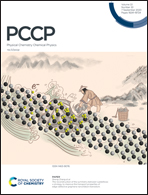Dynamics of isobutane is a sensitive probe for framework breathing in MIL-53 (Al) MOF†
Abstract
MIL-53 (Al) is an example of a MOF with a flexible framework featuring a broad range of applications such as hydrocarbon adsorption, separation and catalysis. Such processes are strongly influenced by the flexibility of the framework and thus require monitoring of the interrelation between the guest dynamics and framework breathing events. Here, we demonstrate that breathing of the framework can be monitored by probing the isobutane guest dynamics with 2H solid-state nuclear magnetic resonance (2H NMR). We show that a stepwise change in the 2H NMR anisotropic line shape to an isotropic one occurs at 253 K, simultaneous with a notable change of the quadrupole coupling constant QAl0 of the 27Al framework aluminium atom. The stepwise variation of QAl0 is indicative of a breathing event in the MIL-53 (Al) framework structure. Such synchronous change is rationalized in terms of the sharp switch of the guest mobility from anisotropic to isotropic rotation due to the pore expansion upon structural phase transition. It is thus inferred that the dynamics of isobutane confined in the pores represents a very sensitive probe to follow breathing of the MIL-53 (Al) framework with loaded guest molecules.



 Please wait while we load your content...
Please wait while we load your content...